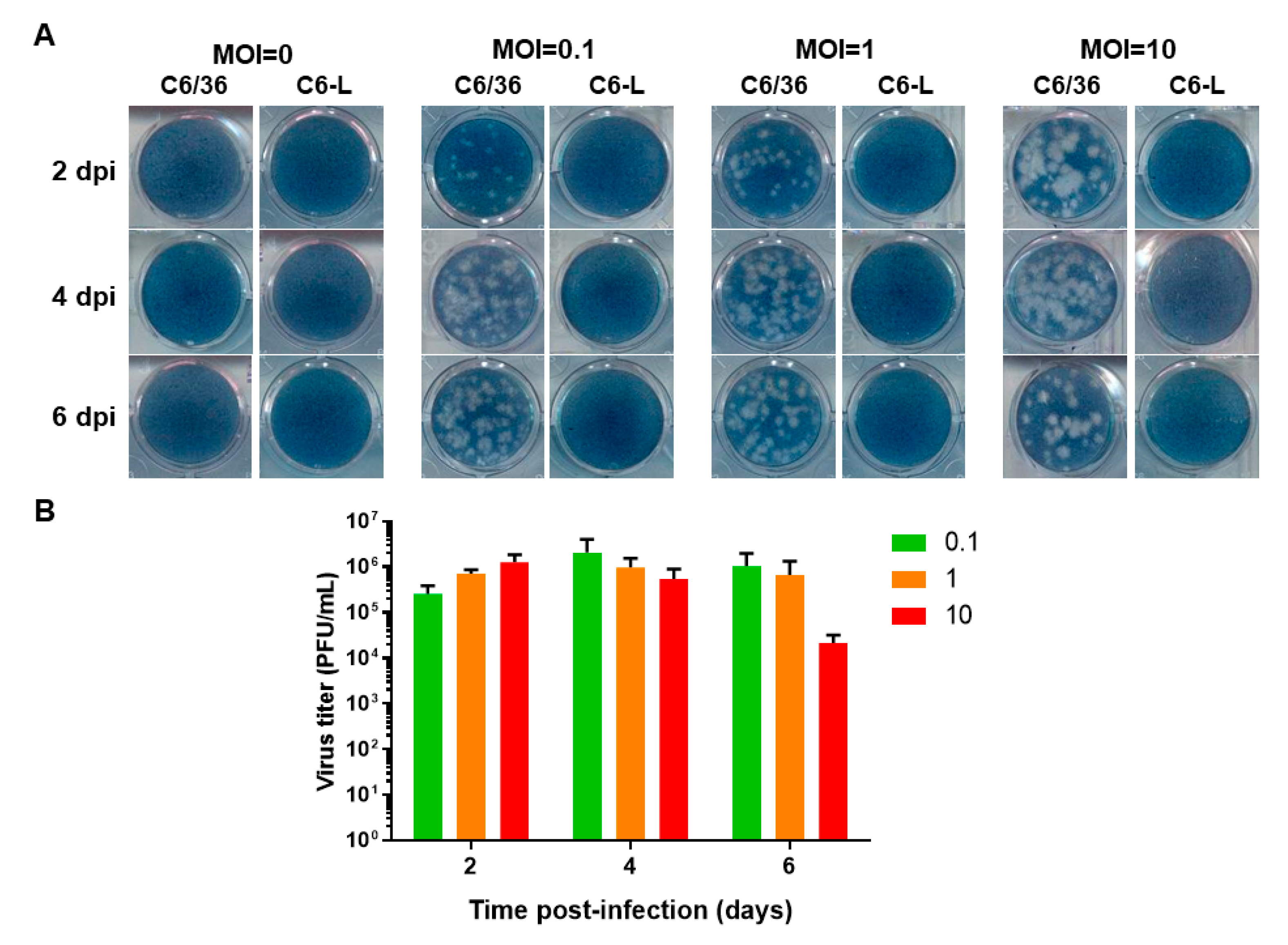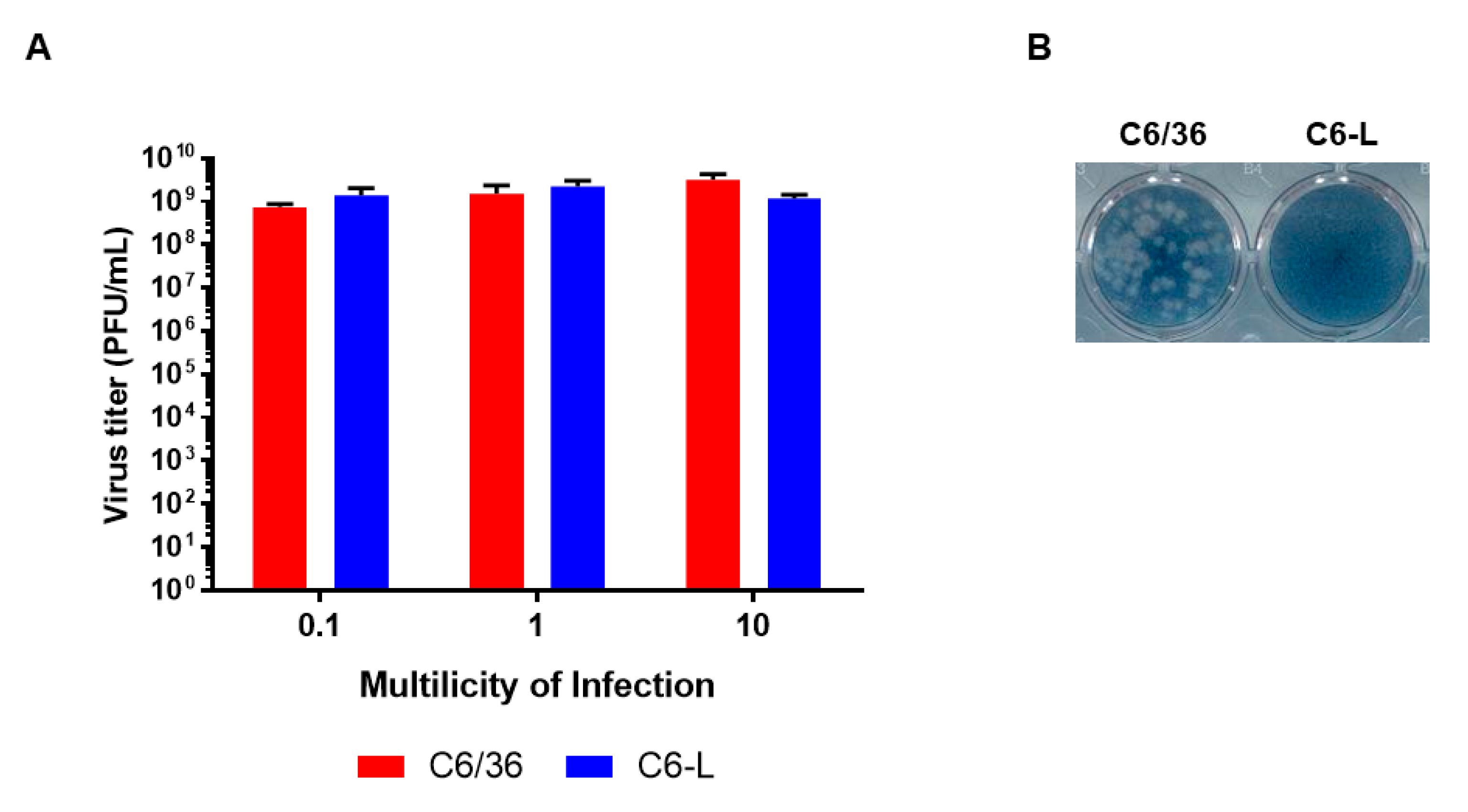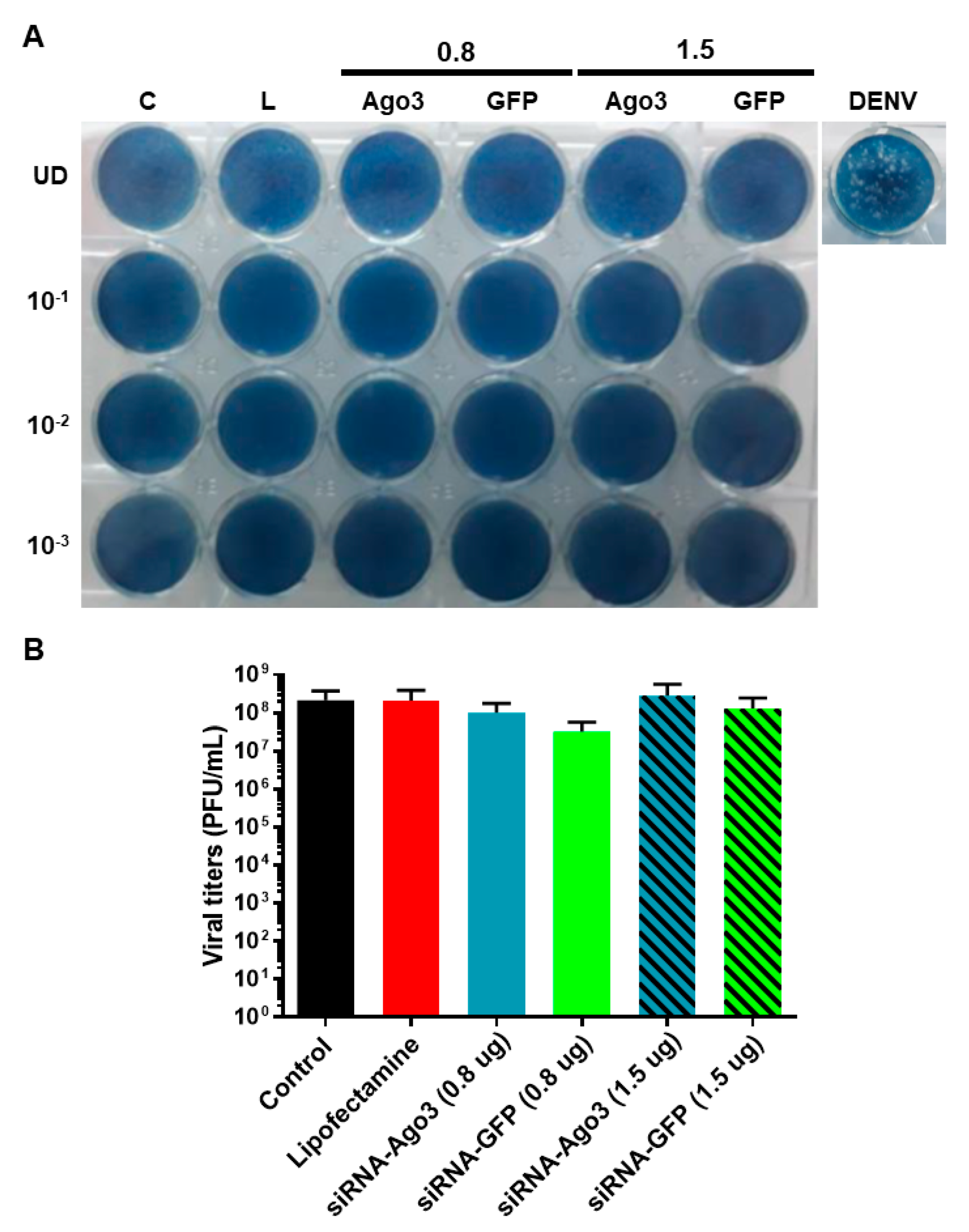Characterization of Viral Interference in Aedes albopictus C6/36 Cells Persistently Infected with Dengue Virus 2
Abstract
:1. Introduction
2. Materials and Methods
2.1. Cells
2.2. Viruses
2.3. Plaque Assay
2.4. RT-PCR Assay
2.5. Evaluation of Viral Interference by Cytopathic Effect
2.6. Viral Interference Assay
2.7. Flow Cytometry Assays
2.8. Silencing of Argonaute 3 Protein
2.9. Cell Viability Assay
2.10. Statistical Analysis
3. Results
3.1. Assessment of Viral Interference in C6/36 Cells Persistently Infected with DENV-2
3.2. Assessment of Homologous Viral Interference in C6/36 Cells Persistently Infected with DENV-2
3.3. Assessment of Heterologous Viral Interference in C6/36 Cells Persistently Infected with DENV-2
3.4. Participation of the Genome-Derived P-Element-Induced Wimpy Testis (PIWI) Pathway in Viral Interference
4. Discussion
5. Conclusions
Supplementary Materials
Author Contributions
Funding
Institutional Review Board Statement
Data Availability Statement
Acknowledgments
Conflicts of Interest
References
- Sivaram, A.; Barde, P.V.; Gokhale, M.D.; Singh, D.K.; Mourya, D.T. Evidence of co-infection of chikungunya and densonucleosis viruses in C6/36 cell lines and laboratory infected Aedes aegypti (L.) mosquitoes. Parasites Vectors 2010, 3, 95. [Google Scholar] [CrossRef] [PubMed]
- Singh, I.R.; Suomalainen, M.; Varadarajan, S.; Garoff, H.; Helenius, A. Multiple Mechanisms for the Inhibition of Entry and Uncoating of Superinfecting Semliki Forest Virus. Virology 1997, 231, 59–71. [Google Scholar] [CrossRef] [PubMed]
- Burivong, P.; Pattanakitsakul, S.-N.; Thongrungkiat, S.; Malasit, P.; Flegel, T.W. Markedly reduced severity of Dengue virus infection in mosquito cell cultures persistently infected with Aedes albopictus densovirus (AalDNV). Virology 2004, 329, 261–269. [Google Scholar] [CrossRef] [PubMed]
- Karpf, A.R.; Lenches, E.; Strauss, E.G.; Strauss, J.H.; Brown, D.T. Superinfection exclusion of alphaviruses in three mosquito cell lines persistently infected with Sindbis virus. J. Virol. 1997, 71, 7119–7123. [Google Scholar] [CrossRef] [PubMed]
- Dittmar, D.; Castro, A.; Haines, H. Demonstration of Interference between Dengue Virus Types in Cultured Mosquito Cells using Monoclonal Antibody Probes. J. Gen. Virol. 1982, 59 Pt 2, 273–282. [Google Scholar] [CrossRef]
- Blair, C.D.; Adelman, Z.N.; Olson, K.E. Molecular Strategies for Interrupting Arthropod-Borne Virus Transmission by Mosquitoes. Clin. Microbiol. Rev. 2000, 13, 651–661. [Google Scholar] [CrossRef]
- Stollar, V.; Shenk, T.E.; Koo, R.; Igarashi, A.; Schlesinger, R.W. Observations of Aedes albopictus cell cultures persistently infected with Sindbis virus. Ann. N. Y. Acad. Sci. 1975, 266, 214–231. [Google Scholar] [CrossRef]
- Riedel, B.; Brown, D.T. Role of extracellular virus on the maintenance of the persistent infection induced in Aedes albopictus (mosquito) cells by Sindbis virus. J. Virol. 1977, 23, 554–561. [Google Scholar] [CrossRef]
- Igarashi, A.; Koo, R.; Stollar, V. Evolution and properties of Aedes albopictus cell cultures persistently infected with sindbis virus. Virology 1977, 82, 69–83. [Google Scholar] [CrossRef]
- Igarashi, A. Characteristics of Aedes albopictus cells persistently infected with dengue viruses. Nature 1979, 280, 690–691. [Google Scholar] [CrossRef]
- Igarashi, A. Production of temperature-sensitive and pathogenic virus from Aedes albopictus cells (Singh) persistently infected with chikungunya virus. Arch. Virol. 1979, 62, 303–312. [Google Scholar] [CrossRef] [PubMed]
- Lee, C.-H.; Schloemer, R.H. Mosquito cells infected with banzi virus secrete an antiviral activity which is of viral origin. Virology 1981, 110, 402–410. [Google Scholar] [CrossRef]
- Lee, C.-H.; Schloemer, R.H. Identification of the antiviral factor in culture medium of mosquito cells persistently infected with Banzi virus. Virology 1981, 110, 445–454. [Google Scholar] [CrossRef] [PubMed]
- Elliott, R.M.; Wilkie, M.L. Persistent infection of Aedes albopictus C6/36 cells by Bunyamwera virus. Virology 1986, 150, 21–32. [Google Scholar] [CrossRef] [PubMed]
- Randolph, V.B.; Hardy, J.L. Phenotypes of St Louis Encephalitis Virus Mutants Produced in Persistently Infected Mosquito Cell Cultures. J. Gen. Virol. 1988, 69 Pt 9, 2199–2207. [Google Scholar] [CrossRef] [PubMed]
- Scallan, M.F.; Elliott, R.M. Defective RNAs in mosquito cells persistently infected with Bunyamwera virus. J. Gen. Virol. 1992, 73 Pt 1, 53–60. [Google Scholar] [CrossRef]
- Zhang, P.-F.; Klutch, M.; Muller, J.; Marcus-Sekura, C.J. St Louis encephalitis virus establishes a productive, cytopathic and persistent infection of Sf9 cells. J. Gen. Virol. 1993, 74 Pt 8, 1703–1708. [Google Scholar] [CrossRef]
- Chen, W.-J.; Chen, S.-L.; Fang, A.-H. Phenotypic Characteristics of Dengue 2 Virus Persistently Infected in a C6/36 Clone of Aedes albopictus Cells. Intervirology 1994, 37, 25–30. [Google Scholar] [CrossRef]
- Tsai, K.-N.; Tsang, S.-F.; Huang, C.-H.; Chang, R.-Y. Defective interfering RNAs of Japanese encephalitis virus found in mosquito cells and correlation with persistent infection. Virus Res. 2007, 124, 139–150. [Google Scholar] [CrossRef]
- Kanthong, N.; Khemnu, N.; Sriurairatana, S.; Pattanakitsakul, S.-N.; Malasit, P.; Flegel, T.W. Mosquito cells accommodate balanced, persistent co-infections with a densovirus and Dengue virus. Dev. Comp. Immunol. 2008, 32, 1063–1075. [Google Scholar] [CrossRef]
- Juárez-Martínez, A.B.; Salas-Benito, M.; García-Espitia, M.; De Nova-Ocampo, M.; del Ángel, R.M.; Salas-Benito, J.S. Detection and sequencing of defective viral genomes in C6/36 cells persistently infected with dengue virus 2. Arch. Virol. 2013, 158, 583–599. [Google Scholar] [CrossRef] [PubMed]
- Igarashi, A. Isolation of a Singh’s Aedes albopictus Cell Clone Sensitive to Dengue and Chikungunya Viruses. J. Gen. Virol. 1978, 40, 531–544. [Google Scholar] [CrossRef] [PubMed]
- Kuno, G.; Oliver, A. Maintaining mosquito cell lines at high tempetatures: Effects on the replication of flaviviruses. In Vitro Cell. Dev. Biol. 1989, 25, 193–196. [Google Scholar] [CrossRef] [PubMed]
- Morens, D.M.; Halstead, S.B.; Repik, P.M.; Putvatana, R.; Raybourne, N. Simplified plaque reduction neutralization assay for dengue viruses by semimicro methods in BHK-21 cells: Comparison of the BHK suspension test with standard plaque reduction neutralization. J. Clin. Microbiol. 1985, 22, 250–254. [Google Scholar] [CrossRef]
- Acuña, B.; Castillo, R.; García, M. Neutralización por reducción de placas como método específico para el diagnóstico serológico de Fiebre Amarilla. Rev. Peru. Med. Exp. Salud Pública 2001, 18, 71–76. [Google Scholar]
- Vega-Almeida, T.O.; Salas-Benito, M.; De Nova-Ocampo, M.A.; Del Angel, R.M.; Salas-Benito, J.S. Surface proteins of C6/36 cells involved in dengue virus 4 binding and entry. Arch. Virol. 2013, 158, 1189–1207. [Google Scholar] [CrossRef]
- Scott, J.C.; Brackney, D.E.; Campbell, C.L.; Bondu-Hawkins, V.; Hjelle, B.; Ebel, G.D.; Olson, K.E.; Blair, C.D. Comparison of Dengue Virus Type 2-Specific Small RNAs from RNA Interference-Competent and –Incompetent Mosquito Cells. PLoS Negl. Trop. Dis. 2010, 4, e848. [Google Scholar] [CrossRef]
- Reyes-Ruiz, J.M.; Osuna-Ramos, J.F.; Bautista-Carbajal, P.; Jaworski, E.; Soto-Acosta, R.; Cervantes-Salazar, M.; Angel-Ambrocio, A.H.; Castillo-Munguía, J.P.; Chávez-Munguía, B.; De Nova-Ocampo, M.; et al. Mosquito cells persistently infected with dengue virus produce viral particles with host-dependent replication. Virology 2019, 531, 1–18. [Google Scholar] [CrossRef]
- Yazi Mendoza, M.; Salas-Benito, J.S.; Lanz-Mendoza, H.; Hernández-Martínez, S.; del Angel, R.M. A putative receptor for dengue virus in mosquito tissues: Localization of a 45-kDa glycoprotein. Am. J. Trop. Med. Hyg. 2002, 67, 76–84. [Google Scholar] [CrossRef]
- Brackney, D.E.; Scott, J.C.; Sagawa, F.; Woodward, J.E.; Miller, N.A.; Schilkey, F.D.; Mudge, J.; Wilusz, J.; Olson, K.E.; Blair, C.D.; et al. C6/36 Aedes albopictus Cells Have a Dysfunctional Antiviral RNA Interference Response. PLoS Negl. Trop. Dis. 2010, 4, e856. [Google Scholar] [CrossRef]
- Miesen, P.; Girardi, E.; van Rij, R.P. Distinct sets of PIWI proteins produce arbovirus and transposon-derived piRNAs in Aedes aegypti mosquito cells. Nucleic Acids Res. 2015, 43, 6545–6556. [Google Scholar] [CrossRef] [PubMed]
- Poidinger, M.; Coelen, R.J.; Mackenzie, J.S. Persistent infection of Vero cells by the flavivirus Murray Valley encephalitis virus. J. Gen. Virol. 1991, 72 Pt 3, 573–578. [Google Scholar] [CrossRef] [PubMed]
- Schmaljohn, C.; Blair, C.D. Persistent infection of cultured mammalian cells by Japanese encephalitis virus. J. Virol. 1977, 24, 580–589. [Google Scholar] [CrossRef] [PubMed]
- Yoon, S.W.; Lee, S.-Y.; Won, S.-Y.; Park, S.-H.; Park, S.-Y.; Jeong, Y.S. Characterization of homologous defective interfering RNA during persistent infection of Vero cells with Japanese encephalitis virus. Mol. Cells 2006, 21, 112–120. [Google Scholar]
- Feng, G.; Takegami, T.; Zhao, G. Characterization and E protein expression of mutant strains during persistent infection of KN73 cells with Japanese encephalitis virus. Chin. Med. J. 2002, 115, 1324–1327. [Google Scholar]
- Beaty, B.J.; Bishop, D.H.; Gay, M.; Fuller, F. Interference between bunyaviruses in Aedes triseriatus mosquitoes. Virology 1983, 127, 83–90. [Google Scholar] [CrossRef]
- Riedel, B.; Brown, D.T. Novel antiviral activity found in the media of Sindbis virus-persistently infected mosquito (Aedes albopictus) cell cultures. J. Virol. 1979, 29, 51–60. [Google Scholar] [CrossRef]
- E Newton, S.; Dalgarno, L. Antiviral activity released from Aedes albopictus cells persistently infected with Semliki forest virus. J. Virol. 1983, 47, 652–655. [Google Scholar] [CrossRef]
- Luo, T.; Brown, D.T. Purification and Characterization of a Sindbis Virus-Induced Peptide Which Stimulates Its Own Production and Blocks Virus RNA Synthesis. Virology 1993, 194, 44–49. [Google Scholar] [CrossRef]
- Luo, T.; Brown, D.T. A 55-kDa Protein Induced in Aedes albopictus (Mosquito) Cells by Antiviral Protein. Virology 1994, 200, 200–206. [Google Scholar] [CrossRef]
- Goic, B.; Vodovar, N.; A Mondotte, J.; Monot, C.; Frangeul, L.; Blanc, H.; Gausson, V.; Vera-Otarola, J.; Cristofari, G.; Saleh, M.-C. RNA-mediated interference and reverse transcription control the persistence of RNA viruses in the insect model Drosophila. Nat. Immunol. 2013, 14, 396–403. [Google Scholar] [CrossRef]
- Goic, B.; Stapleford, K.A.; Frangeul, L.; Doucet, A.J.; Gausson, V.; Blanc, H.; Schemmel-Jofre, N.; Cristofari, G.; Lambrechts, L.; Vignuzzi, M.; et al. Virus-derived DNA drives mosquito vector tolerance to arboviral infection. Nat. Commun. 2016, 7, 12410. [Google Scholar] [CrossRef]
- Samuel, G.H.; Pohlenz, T.; Dong, Y.; Coskun, N.; Adelman, Z.N.; Dimopoulos, G.; Myles, K.M. RNA interference is essential to modulating the pathogenesis of mosquito-borne viruses in the yellow fever mosquito Aedes aegypti. Proc. Natl. Acad. Sci. USA 2023, 120, e2213701120. [Google Scholar] [CrossRef] [PubMed]
- Göertz, G.P.; Miesen, P.; Overheul, G.J.; van Rij, R.P.; van Oers, M.M.; Pijlman, G.P. Mosquito Small RNA Responses to West Nile and Insect-Specific Virus Infections in Aedes and Culex Mosquito Cells. Viruses 2019, 11, 271. [Google Scholar] [CrossRef] [PubMed]
- Morazzani, E.M.; Wiley, M.R.; Murreddu, M.G.; Adelman, Z.N.; Myles, K.M. Production of Virus-Derived Ping-Pong-Dependent piRNA-like Small RNAs in the Mosquito Soma. PLoS Pathog. 2012, 8, e1002470. [Google Scholar] [CrossRef] [PubMed]
- Whitfield, Z.J.; Dolan, P.T.; Kunitomi, M.; Tassetto, M.; Seetin, M.G.; Oh, S.; Heiner, C.; Paxinos, E.; Andino, R. The Diversity, Structure, and Function of Heritable Adaptive Immunity Sequences in the Aedes aegypti Genome. Curr. Biol. 2017, 27, 3511–3519.e7. [Google Scholar] [CrossRef] [PubMed]
- Varjak, M.; Leggewie, M.; Schnettler, E. The antiviral piRNA response in mosquitoes? J. Gen. Virol. 2018, 99, 1551–1562. [Google Scholar] [CrossRef]
- Akbari, O.S.; Antoshechkin, I.; Amrhein, H.; Williams, B.; Diloreto, R.; Sandler, J.; A Hay, B. The Developmental Transcriptome of the Mosquito Aedes aegypti, an Invasive Species and Major Arbovirus Vector. G3 2013, 3, 1493–1509. [Google Scholar] [CrossRef]
- Blair, C.D. Deducing the Role of Virus Genome-Derived PIWI-Associated RNAs in the Mosquito–Arbovirus Arms Race. Front. Genet. 2019, 10, 1114. [Google Scholar] [CrossRef]
- Zhou, X.; Liao, Z.; Jia, Q.; Cheng, L.; Li, F. Identification and characterization of Piwi subfamily in insects. Biochem. Biophys. Res. Commun. 2007, 362, 126–131. [Google Scholar] [CrossRef]
- Girardi, E.; Miesen, P.; Pennings, B.; Frangeul, L.; Saleh, M.-C.; van Rij, R.P. Histone-derived piRNA biogenesis depends on the ping-pong partners Piwi5 and Ago3 in Aedes aegypti. Nucleic Acids Res. 2017, 45, 4881–4892. [Google Scholar] [CrossRef] [PubMed]
- Wang, Y.; Jin, B.; Liu, P.; Li, J.; Chen, X.; Gu, J. piRNA Profiling of Dengue Virus Type 2-Infected Asian Tiger Mosquito and Midgut Tissues. Viruses 2018, 10, 213. [Google Scholar] [CrossRef] [PubMed]
- Marconcini, M.; Hernandez, L.; Iovino, G.; Houé, V.; Valerio, F.; Palatini, U.; Pischedda, E.; Crawford, J.E.; White, B.J.; Lin, T.; et al. Polymorphism analyses and protein modelling inform on functional specialization of Piwi clade genes in the arboviral vector Aedes albopictus. PLoS Negl. Trop. Dis. 2019, 13, e0007919. [Google Scholar] [CrossRef] [PubMed]
- Miesen, P.; Ivens, A.; Buck, A.H.; van Rij, R.P. Small RNA Profiling in Dengue Virus 2-Infected Aedes Mosquito Cells Reveals Viral piRNAs and Novel Host miRNAs. PLoS Negl. Trop. Dis. 2016, 10, e0004452. [Google Scholar] [CrossRef]
- Rückert, C.; Prasad, A.N.; Garcia-Luna, S.M.; Robison, A.; Grubaugh, N.D.; Weger-Lucarelli, J.; Ebel, G.D. Small RNA responses of Culex mosquitoes and cell lines during acute and persistent virus infection. Insect Biochem. Mol. Biol. 2019, 109, 13–23. [Google Scholar] [CrossRef]
- Varjak, M.; Donald, C.L.; Mottram, T.J.; Sreenu, V.B.; Merits, A.; Maringer, K.; Schnettler, E.; Kohl, A. Characterization of the Zika virus induced small RNA response in Aedes aegypti cells. PLoS Negl. Trop. Dis. 2017, 11, e0006010. [Google Scholar] [CrossRef]
- Varjak, M.; Maringer, K.; Watson, M.; Sreenu, V.B.; Fredericks, A.C.; Pondeville, E.; Donald, C.L.; Sterk, J.; Kean, J.; Vazeille, M.; et al. Aedes aegypti Piwi4 Is a Noncanonical PIWI Protein Involved in Antiviral Responses. mSphere 2017, 2, e00144-17. [Google Scholar] [CrossRef]
- Marconcini, M.; Pischedda, E.; Houé, V.; Palatini, U.; Lozada-Chávez, N.; Sogliani, D.; Failloux, A.-B.; Bonizzoni, M. Profile of Small RNAs, vDNA Forms and Viral Integrations in Late Chikungunya Virus Infection of Aedes albopictus Mosquitoes. Viruses 2021, 13, 553. [Google Scholar] [CrossRef]
- Hess, A.M.; Prasad, A.N.; Ptitsyn, A.; Ebel, G.D.; E Olson, K.; Barbacioru, C.; Monighetti, C.; Campbell, C.L. Small RNA profiling of Dengue virus-mosquito interactions implicates the PIWI RNA pathway in anti-viral defense. BMC Microbiol. 2011, 11, 45. [Google Scholar] [CrossRef]
- Sinclair, J.B.; Asgari, S. Ross River Virus Provokes Differentially Expressed MicroRNA and RNA Interference Responses in Aedes aegypti Mosquitoes. Viruses 2020, 12, 695. [Google Scholar] [CrossRef]
- Walsh, E.; Torres, T.Z.B.; Rückert, C. Culex Mosquito Piwi4 Is Antiviral against Two Negative-Sense RNA Viruses. Viruses 2022, 14, 2758. [Google Scholar] [CrossRef] [PubMed]
- Yen, P.-S.; Chen, C.-H.; Sreenu, V.; Kohl, A.; Failloux, A.-B. Assessing the Potential Interactions between Cellular miRNA and Arboviral Genomic RNA in the Yellow Fever Mosquito, Aedes aegypti. Viruses 2019, 11, 540. [Google Scholar] [CrossRef] [PubMed]
- Eng, M.W.; Clemons, A.; Hill, C.; Engel, R.; Severson, D.W.; Behura, S.K. Multifaceted functional implications of an endogenously expressed tRNA fragment in the vector mosquito Aedes aegypti. PLoS Negl. Trop. Dis. 2018, 12, e0006186. [Google Scholar] [CrossRef] [PubMed]
- Kumar, V.; Garg, S.; Gupta, L.; Gupta, K.; Diagne, C.T.; Missé, D.; Pompon, J.; Kumar, S.; Saxena, V. Delineating the Role of Aedes aegypti ABC Transporter Gene Family during Mosquito Development and Arboviral Infection via Transcriptome Analyses. Pathogens 2021, 10, 1127. [Google Scholar] [CrossRef]
- Kajla, M.; Kakani, P.; Choudhury, T.P.; Gupta, K.; Gupta, L.; Kumar, S. Characterization and expression analysis of gene encoding heme peroxidase HPX15 in major Indian malaria vector Anopheles stephensi (Diptera: Culicidae). Acta Trop. 2016, 158, 107–116. [Google Scholar] [CrossRef] [PubMed]






Disclaimer/Publisher’s Note: The statements, opinions and data contained in all publications are solely those of the individual author(s) and contributor(s) and not of MDPI and/or the editor(s). MDPI and/or the editor(s) disclaim responsibility for any injury to people or property resulting from any ideas, methods, instructions or products referred to in the content. |
© 2023 by the authors. Licensee MDPI, Basel, Switzerland. This article is an open access article distributed under the terms and conditions of the Creative Commons Attribution (CC BY) license (https://creativecommons.org/licenses/by/4.0/).
Share and Cite
González-Flores, A.M.; Salas-Benito, M.; Rosales-García, V.H.; Zárate-Segura, P.B.; Del Ángel, R.M.; De Nova-Ocampo, M.A.; Salas-Benito, J.S. Characterization of Viral Interference in Aedes albopictus C6/36 Cells Persistently Infected with Dengue Virus 2. Pathogens 2023, 12, 1135. https://doi.org/10.3390/pathogens12091135
González-Flores AM, Salas-Benito M, Rosales-García VH, Zárate-Segura PB, Del Ángel RM, De Nova-Ocampo MA, Salas-Benito JS. Characterization of Viral Interference in Aedes albopictus C6/36 Cells Persistently Infected with Dengue Virus 2. Pathogens. 2023; 12(9):1135. https://doi.org/10.3390/pathogens12091135
Chicago/Turabian StyleGonzález-Flores, Aurora Montsserrat, Mariana Salas-Benito, Victor Hugo Rosales-García, Paola Berenice Zárate-Segura, Rosa María Del Ángel, Mónica Ascención De Nova-Ocampo, and Juan Santiago Salas-Benito. 2023. "Characterization of Viral Interference in Aedes albopictus C6/36 Cells Persistently Infected with Dengue Virus 2" Pathogens 12, no. 9: 1135. https://doi.org/10.3390/pathogens12091135
APA StyleGonzález-Flores, A. M., Salas-Benito, M., Rosales-García, V. H., Zárate-Segura, P. B., Del Ángel, R. M., De Nova-Ocampo, M. A., & Salas-Benito, J. S. (2023). Characterization of Viral Interference in Aedes albopictus C6/36 Cells Persistently Infected with Dengue Virus 2. Pathogens, 12(9), 1135. https://doi.org/10.3390/pathogens12091135






